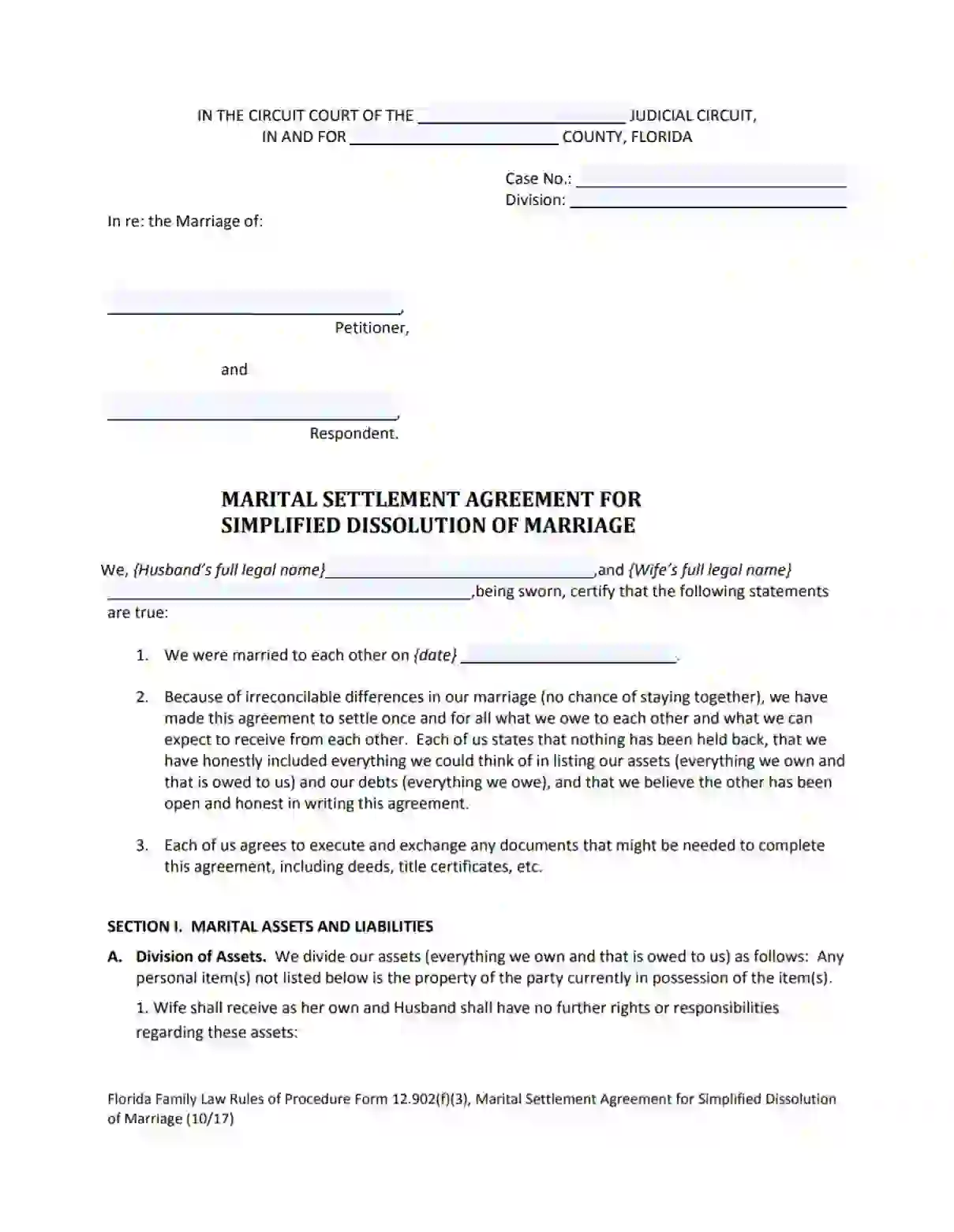Florida Marital Settlement (Divorce) Agreement and Legal Separation
When two people decide to terminate their marriage in Florida, they need to complete the Florida Marital Settlement Agreement. This document is needed the most during the divorce proceedings.
The Florida Marital Settlement Agreement regulates the ex-spouses’ obligations and rights. Partners can decide on their own what to include in the marital settlement agreement template, but usually, there are details about kids’ support, alimony, parental responsibilities, and estate separation.

Build Your Document
Answer a few simple questions to make your document in minutes
Save and Print
Save progress and finish on any device, download and print anytime
Sign and Use
Your valid, lawyer-approved document is ready
Florida Divorce Laws
The main document in Florida covering the laws and requirements of the separation proceedings is the 2020 Florida Statutes. To be more precise, all the details can be found in Title VI, Chapter 61 (Dissolution of Marriage; Support; Time-Sharing).
Kids’ Support
You can find data on this in §61.29 and §61.30.
The amount of alimony depends on several factors, including the number of kids in the family, medical costs, the amount of time parents spend with the kids, and parents’ prosperity.
Grounds for Separation
Information on this topic can be found in §61.052.
There are two reasons why the court can choose to award the divorce:
- If one of the partners is mentally unstable
- If there’s nothing left from the marriage
Alimony
Search for this data in §61.08(2).
The court will make a ruling regarding the alimony based on the following:
- Parents’ education and earning capability
- The necessity of the alimony
- Parents’ actual incomes
- Parents’ physical and mental health
- Parents’ age
- Parents’ working conditions
- How successfully parents maintain their parental obligations
Property Division
§61.075 of the 2020 Florida Statutes covers this topic.
Florida is a state with equitable distribution law, which means judges try to split the property fairly, not evenly.
Residency
One of the partners must be a Florida resident for at least six months for the marital partners to ask for a divorce in Florida (§61.021).
Popular Local Marital Settlement Agreement Forms
A marital settlement agreement, also known as a separation agreement, is a convenient instrument that might enable you to negotiate the divorce and avoid needless stress. The following are the states the people of which search for this form the most.
Interim Support
If one of the partners needs financial support during separation proceedings, they can demand temporary financial support or “alimony pendente lite” to cover one’s everyday needs (§61.071).

Filing for Divorce in Florida
We have a form-building software that you can use to fill the Florida Marital Settlement Agreement. The software saves your time and allows you to spend this saved time as you like.
The separation process takes around three months in Florida, and the filing fee for applying for one starts from $409.
1. Select the Separation Form
Separation forms vary depending on the kids’ presence in the family.
If partners have kids, they can consider completing one of the forms:
- Answer to Petition for Dissolution of Marriage (12.903(b))
- Certificate of Compliance with Mandatory Disclosure (12.932)
- Petition for Dissolution of Marriage with Property but No Dependent or Minor Child(ren) (12.901(b)(2))
- Notice of Hearing Before General Magistrate (12.920(c))
- Others.
If partners have no kids, they can stop their choice on of the following forms:
- Cover Sheet for Family Court Cases (12.928)
- Affidavit of Corroborating Witness (12.902(i))
- Family Law Financial Affidavit (Long Form) (12.902(c))
- Notice of Hearing (Child Support Enforcement Hearing Officer) (12.921)
- Others.
2. File the Petition
If one or both spouses want to separate, they should submit a petition with the Circuit Court. The partner initiating a separation is the “petitioner,” while the other partner is the “respondent.”
It’s essential to pick the petition that suits partners’ demands the best. Here’s the list of the existing petitions needed for the separation process to come into force:
- Petition for Dissolution of Marriage with Property but No Dependent or Minor Child(ren)
- Petition for Dissolution of Marriage With Dependent or Minor Child(ren)
- Petition for Dissolution of Marriage with No Dependent or Minor Child(ren)
- Petition for Simplified Dissolution of Marriage—partners can utilize this petition if they serve the following requirements:
- Partners don’t pretend on receiving the alimony
- Partners don’t have minors or dependent children
- The wife isn’t pregnant
- Partners don’t intend to use their right to appeal and a trial
- Partners know how to divide their estate and belongings
- Partners will come to the court for the final hearing
When partners choose the right petition, the petitioner must sign it in front of an assistant registrar or a notary public agent.
3. Confirm the Presence of the Residency
Only Florida residents who have lived in the state for at least six months can initiate the separation proceedings. There are several ways to prove one’s residence in Florida:
- A partner can show a copy of their identification card, a driver’s license, or a voter registration card. One needs to attach them to other separation papers.
- A third party can fill out an Affidavit of Corroborating Witness in front of a notary public agent.
4. Complete Additional Mandatory Disclosures
With the separation papers, partners need to pick disclosures applying their separation case. Here’s the list of some of these disclosures:
- Notice of Social Security Number. Partners don’t need to file this one if they have a simplified marriage dissolution.
- Marital Settlement Agreement for Dissolution of Marriage with Property but No Dependent or Minor Child(ren)
- Family Law Financial Affidavit (Long Form). A partner with an income of $50,000 at least can file this form.
- Family Law Financial Affidavit (Short Form). A partner with an income of less than $50,000 must file this form.
- Certificate of Compliance with Mandatory Disclosure. Partners don’t need to file this one if they have a simplified marriage dissolution.
Partners have to sign these discloses in front of a notary public agent or an assistant registrar.
5. Provide the Parenting Papers
If partners have dependent or minor children, or if the wife is pregnant, they need to complete additional documents and attach them to the other separation papers. The court needs to examine these papers to understand how parents will fulfill their parental obligations, pay for child support, and serve the kid’s custody.
Here’s the list of the necessary parenting papers:
- Uniform Child Custody Jurisdiction and Enforcement Affidavit
- Parenting Plan
- Child Support Guidelines Worksheet
6. Fill Out the Separation Papers
The petitioner needs to complete a Cover Sheet for Family Court Cases in one copy and other separation papers in two copies. Afterward, they need to deliver them to the Circuit Court and pay the filing fee of $409 (or more if there’re kids in the family or alimony). When the petitioner can’t pay the filing fee, they can fill out an Application for Determination of Civil Indigent Status.
Note you can submit many papers online via Florida Courts E-Filing Portal. Ask your registrar for more information on this.
7. Deliver Papers to the Respondent
When the petitioner finishes filing separation papers, they need to complete a Summons: Personal Service on an Individual and Process Service Memorandum. After that, a secretory will sign them and return them to the petitioner.
The petitioner can’t deliver separation papers (including memorandum, summons, and copies of all divorce papers) on their own. They have to use the services of the sheriff’s department or a private process server. They can also deliver divorce papers straight to the respondent or to an individual aged at least 15 years living with the respondent for an additional fee.
The petitioner will get the proof of service as soon as the documents are delivered. It is their responsibility to ensure the court received the proof of service.
8. Get the Respondent Answer the Petition
The respondent has 20 days to answer the received petition—they can either agree or disagree with it. Suppose they agree with every point in the petition and don’t want to go to court (preferring to receive the final answer by mail). In that case, they need to file an Answer, Waiver, and Request for Copy of Final Judgement of Dissolution of Marriage. If the respondent has some disagreements with the received petition, they must file an Answer to Petition for Dissolution of Marriage. One has to do it in front of an assistant registrar or a notary public agent. One of the signed copies belongs to the petitioner.
9. Set a Hearing Date
One of the partners can reach a registrar seeking to establish a hearing date for the separation case. When the registrar chooses the date, the partner needs to file one of the documents listed below with the court.
- Notice of Hearing Before General Magistrate
- Notice of Hearing (Child Support Enforcement Hearing Officer)
- Notice of Hearing (General)
A general magistrate, child support enforcement hearing officer, or judge has the right to hold the hearing.
10. Visit a Hearing
Both partners have to come to the court on the established date and time of the hearing. During the hearing, the judge will examine all divorce case information and make the final decision based on this information. If they decide to grant the divorce, one signs a Final Judgement, without which the divorce termination can’t be possible.
Here’s the list of the Final Judgement forms:
- Final Judgement of Dissolution of Marriage with No Property or Dependent or Minor Child(ren)
- Final Judgement of Simplified Dissolution of Marriage
- Final Judgement of Dissolution of Marriage with Dependent or Minor Child(ren)
- Final Judgement of Dissolution of Marriage with Property but No Dependent or Minor Child(ren)
11. Change the Name
If one of the partners intends to return their maiden name, they need to go to the clerk’s office and demand an exact duplicate of the final judgment. In the future, they can bring it to the Social Security Administration, Department of Highway Safety and Motor Vehicles, and other institutions.
Former marital partners can marry any time after the divorce proceedings termination again.

Interested in more Florida documents? We offer free forms and simple personalization experience to everyone who wants having fewer to none problems when confronted with papers.
Other Marital Settlement Agreement Forms by State